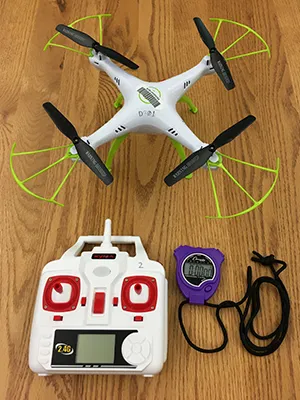How fast can my drone fly?
Goal
An after-school group decided they wanted to use a UAV (Unmanned Aerial Vehicle or "drone") to take a photo of a specific tree on their campus every day. In order to figure out how much time it would take to fly out to the tree, get the picture, and fly back each day, they needed an estimate of the drone’s average forward speed.
Materials

- One or more UAV (Unmanned Aerial Vehicle or "drone") and the controller used to fly it
- Sports field with marked distances
- Stopwatches
- Several people to serve as timers/spotters
Preparation
Prior to beginning the activity, hold a class discussion to help students create their experimental design. Use the topics and prompts below to guide your discussion.
Ask students what they will do to collect the information they need. Have them consider the following questions:
- How can I measure the drone’s average speed over a certain distance without including the time it takes to launch and get up to speed?
- What minimum distance should the drone cover in each trial to get an accurate estimate of its speed? 5 yards? 50 yards?
- What did you find was the perfect distance for your testing and why?
Ask students what they will do to make sure each trial is fair. Have them consider the following questions:
- How can I make sure every trial is consistent?
- Are all spotters/timers following the exact same procedure? Are spotters' results the same or close on each trial?
- What environmental or drone-based variables could interfere with your tests? How much error could those variables introduce into your results? How could you accommodate for those variables so that each trial is a fair comparison of how fast your drone can fly?
Ask students to think about how many separate trials will be needed to feel confident in their final answer. Have them consider the following questions:
- What are the practical limits of flying your drone as fast as it can go?
- At the maximum practical speed you identified, how long would it take for the drone to fly out of the effective range of its controller?
Ask students to think about how they will document their results. Have them consider the following questions:
- What kind of graphics, videos, and/or photographs would be best to help you document your results?
- Could you construct a diagram to make what you did so clear that another group could set up the same experiment?
Directions
Have students create a table to record data for distance and time for each flight, and to record the calculated speed for each flight. The table should look something like this:
| Distance | Time | Average Speed | |
|---|---|---|---|
| Trial 1 | |||
| Trial 2 | |||
| Trial 3 | |||
| Trial 4 | |||
| Trial 5 |
- Have students fly their UAVs several times to perform the experiment.
- Students should record the distance and time for each flight in their data tables.
- Ask students to calculate the average speed for each flight by dividing the distance by the time.
- Have students use their data to answer the questions in the Preparation section above.
Assessment
- Have students present their results to the rest of the class.
- Encourage students to address the Questions to Consider from the Preparation section (above) in their presentations.
Follow up
If the tree the group wanted to photograph was located 40 yards from the drone launch site, how much time would it take to get the photograph each day? What other factors should the group consider in estimating the time the daily experiment would take?
Credits
This activity was developed by LuAnn Dahlman for Earth Science Information Partners (ESIP).
 It is offered under aCreative Commons Attribution-NonCommercial-ShareAlike license.
It is offered under aCreative Commons Attribution-NonCommercial-ShareAlike license.
Grade Level
- Middle School
- High School
Educational Standards
Next Generation Science Standards
- SEP: asking questions (for science) and defining problems (for engineering)
- SEP: planning and carrying out investigations
- SEP: analyzing and interpreting data
- SEP: using mathematics and computational thinking
- SEP: obtaining, evaluating, and communicating information
- CC: scale, proportion, and quantity
- DCI: MS-PS2.A: Forces and Motion
- DCI: HS-PS2.A: Forces and Motion
- DCI: MS-ETS1.A: Defining and Delimiting Engineering Problems
- DCI: HS-ETS1.A: Defining and Delimiting Engineering Problems